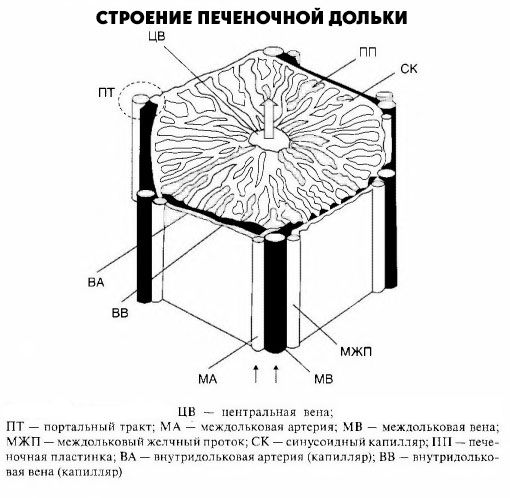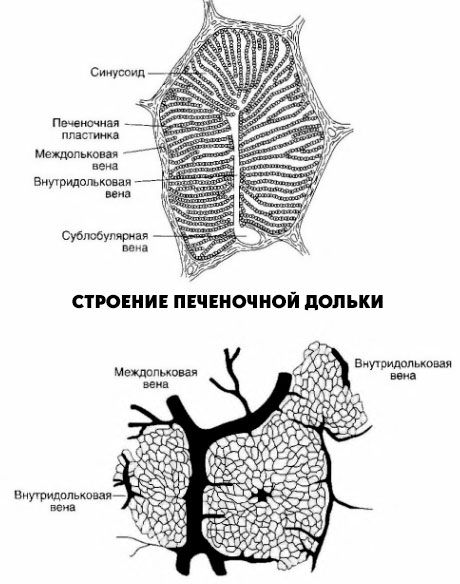Medical expert of the article
New publications
The hepatic lobule as a morphofunctional unit of the liver
Last reviewed: 04.07.2025

All iLive content is medically reviewed or fact checked to ensure as much factual accuracy as possible.
We have strict sourcing guidelines and only link to reputable media sites, academic research institutions and, whenever possible, medically peer reviewed studies. Note that the numbers in parentheses ([1], [2], etc.) are clickable links to these studies.
If you feel that any of our content is inaccurate, out-of-date, or otherwise questionable, please select it and press Ctrl + Enter.
The liver lobule is a morphofunctional unit of the liver. In the center of the lobule is the central vein. The central veins, connecting with each other, eventually flow into the hepatic veins, the latter, in turn, flow into the inferior vena cava. The lobule has the shape of a prism of 1-2 mm. It consists of radially located double rows of cells (liver plates, or beams). Between the rows of hepatocytes are intralobular bile ducts, their ends facing the central vein are closed. The resulting bile is directed to the periphery of the lobules. Between the liver plates are sinusoidal capillaries, where the blood entering the liver through the portal vein and the proper hepatic artery mixes. Along the periphery of the liver lobule are triads: interlobular veins (to which the portal vein branches), interlobular arteries (to which the proper hepatic artery branches), and interlobular bile ducts (which, merging with each other, ultimately form the right and left hepatic ducts).

Thus, inside the liver lobule, bile moves from the center to the periphery and is then removed from the liver through the common bile duct. Blood from the portal vein and the liver's own artery, mixing in the intrahepatic lobule, moves from its periphery to the center and is removed through the central veins into the inferior vena cava system.

The liver lobule is separated from the others by a connective tissue membrane containing collagen and elastin fibers. The total number of liver lobules is about 0.5 million. In 1 minute, 1.2 liters of blood flows through the liver of an adult, almost 70% of which comes through the portal vein.
The functional unit includes a sinusoid with the surrounding space between its endothelium and hepatocytes (Disse's space), adjacent hepatocytes and the bile duct. Some authors believe that the structure of the liver should be considered based on the structure of the afferent and efferent blood vessels, their interweaving,
The condition of the sinusoids is important for clinical evaluation. They have three sections: peripheral, intermediate and central. The intermediate section makes up 90% of their length. Unlike the peripheral and central sections, it does not have a basement membrane. Between the sinusoid endothelium and hepatocytes, there are spaces communicating with the periportal spaces; together with the intercellular gaps, they serve as the beginning of the lymphatic system. It is in these spaces that various substances come into contact with the cytoplasmic membrane of the liver cell.
The endothelium of the sinusoids contains pores that provide the passage of various molecules into hepatocytes. Some of the endothelial cells provide the structure of the sinusoids, while others, such as stellate reticuloendotheliocytes (Kupffer cells), have a phagocytic function or participate in the renewal and formation of connective tissue. These cells make up 40% of all endothelial cells. At the same time, 48% of endothelial cells perform a structural function and 12% - fibroplastic.
The peripheral parts of the liver lobule are formed by small hepatocytes, they participate in the regeneration process and act as a border plate, separating the parenchyma of the lobule from the connective tissue of the portal field. Interlobular veins of the v. portae system and arterioles of the hepatic artery penetrate into the lobule through the border plate, cholangioles exit, flowing into the interlobular hepatic ducts. Between the hepatocytes and the connective tissue there are spaces called Mohl's spaces.
The portal tract on the periphery of the lobule has the form of a triangle with the terminal branches of the portal vein, hepatic artery and interlobular bile duct, called the triad. It includes lymphatic clefts lined with endothelium and nerves that encircle the blood vessels. A rich network of nerve fibers penetrates the liver lobules to hepatocytes and endothelial cells.
Connective tissue in the form of reticulin and collagen fibers, as well as the basal membranes of the sinusoids, blood vessels and bile ducts of the portal tract in children is very delicate and only in older people does it form coarse fibrous accumulations.
Ultrastructure of a hepatocyte
It has been established that different parts of the hepatocyte membrane perform specialized functions. Thus, two-way transport is carried out on the sinusoidal surface, where substances reaching the liver through the portal vein system enter the hepatocyte, and those secreted by the hepatocyte leave it. The membranes of the tubules of neighboring hepatocytes form liver tubules, preventing the secreted substances from entering back into the sinusoid. In the mitochondria of the hepatocyte, the processes of oxidation and metabolism of various substances, including fatty acids, gluconeogenesis, accumulation and release of energy occur. The nucleus and nucleoli are surrounded by a membrane that connects to the endoplasmic reticulum, which is a long network of tubules and cisterns involved in various biochemical processes, including the synthesis of protein, triglycerides, and the metabolism of a number of drugs. The endoplasmic reticulum is part of the microsomal fraction obtained by ultracentrifugation of liver homogenate. The Golgi apparatus (plate complex) "packs" proteins and is involved in the secretion of bile components. Peroxisomes contain enzymes (including oxidase and catalase) and are involved in the metabolism of proteins and bile acids. The hepatocyte has a cytoskeleton consisting of actin filaments, distributed throughout the cell and concentrated at the plasma membrane. Lysosomes contain hydrolase enzymes and play an important role in the intracellular digestion of substances.


 [
[